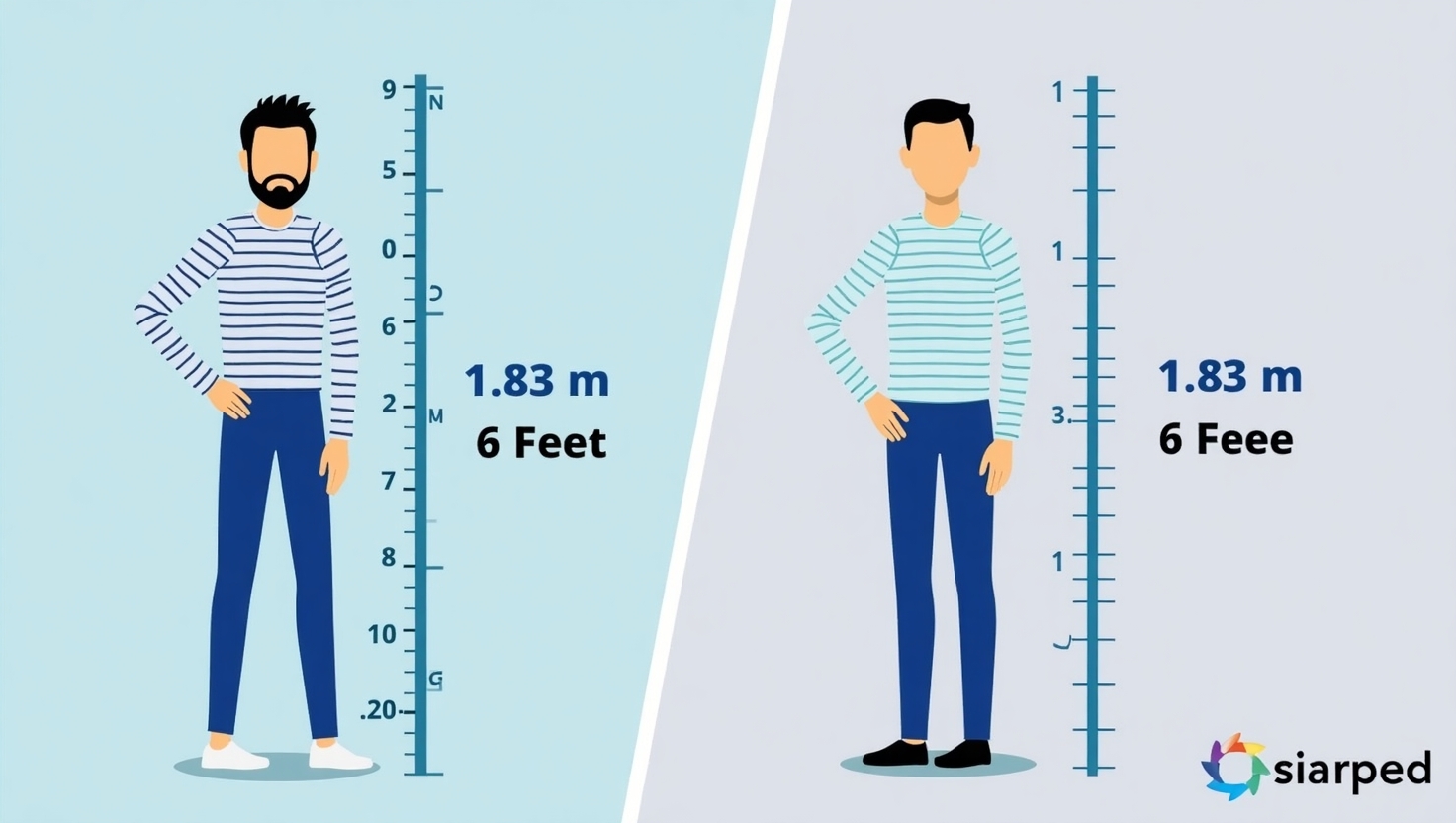
When you hear someone’s height is 1.83 m in feet, you might wonder exactly how tall that is in a unit more familiar to you. Converting 1.83 meters to feet is simple, but understanding the process, its applications, and why it matters can be incredibly useful—whether you’re a student, traveler, or just curious! This measurement, 1.83 m in feet, equals approximately 6 feet, a height common in sports, fashion, or everyday conversations about stature. In this article, we’ll break down the conversion process, explore its significance in various contexts like sports and health, and provide practical tips to make metric-to-imperial conversions a breeze. Let’s dive into the world of measurements and make 1.83 m in feet crystal clear for everyone!
Why Convert 1.83 m in Feet?
Understanding the conversion of 1.83 m in feet is essential for many reasons. In countries like the United States, feet and inches are commonly used, while meters dominate in most other parts of the world. This creates a need for accurate conversions, especially for students learning about global measurement systems or travelers navigating different standards. For instance, if a basketball player’s height is listed as 1.83 m in feet, coaches in the U.S. need to know it’s about 6 feet to assess their suitability for a team. Similarly, in healthcare, converting 1.83 m in feet helps doctors communicate height-related health metrics effectively. Knowing how to convert 1.83 m in feet bridges communication gaps, ensures precision in fields like engineering, and makes everyday comparisons easier for school students and professionals alike.
The Math Behind Converting 1.83 m in Feet
Converting 1.83 m in feet is straightforward with the right formula. One meter equals approximately 3.28084 feet. To convert 1.83 meters, multiply 1.83 by 3.28084. So, 1.83 × 3.28084 = 6.00393732 feet, or roughly 6 feet when rounded for simplicity. For a more precise measurement, you can convert the decimal (0.00393732 feet) into inches, since 1 foot equals 12 inches. Multiply 0.00393732 by 12, and you get about 0.047 inches, which is negligible in most practical scenarios. Thus, 1.83 m in feet is commonly stated as 6 feet. This simple calculation helps students understand metric-to-imperial conversions and is useful in real-world applications like construction or athletics, where precise measurements matter.
Real-World Applications of 1.83 m in Feet
The conversion of 1.83 m in feet has practical uses across various fields. In sports, particularly basketball or volleyball, a height of 1.83 m in feet (6 feet) is often a benchmark for players. Coaches use this to evaluate athletes’ potential for specific roles. In fashion, models around 1.83 m in feet are often preferred for runway shows due to their tall, balanced proportions. For students, understanding 1.83 m in feet can help with science projects involving global data, like comparing average heights across countries. In healthcare, doctors may need to convert 1.83 m in feet to discuss body mass index (BMI) or growth patterns with patients in regions using imperial units. This conversion ensures clarity and accuracy in diverse settings.
How to Convert 1.83 m in Feet Without a Calculator
You don’t always need a calculator to convert 1.83 m in feet! A quick mental math trick can help. Since 1 meter is roughly 3.3 feet, multiply 1.83 by 3.3. Break it down: 1 meter is 3.3 feet, and 0.83 meters is about 0.83 × 3.3 = 2.739 feet. Add them together: 3.3 + 2.739 = 6.039 feet, or approximately 6 feet. This method is great for school students who want a fast estimate without technology. While it’s slightly less precise than using 3.28084, it’s practical for quick conversions in daily life, like estimating someone’s height or measuring objects during a project. Practicing this method builds confidence in handling 1.83 m in feet conversions.
Why 1.83 m in Feet Matters in Sports
In sports, 1.83 m in feet—approximately 6 feet—is a significant height. In basketball, players around this height are often versatile, playing roles like shooting guards or small forwards. For example, a player listed at 1.83 m in feet might excel in agility and shooting rather than dominating under the basket. In volleyball, this height is ideal for setters or liberos, who need quick reflexes. Coaches and scouts often convert 1.83 m in feet to assess if an athlete fits team strategies in countries using imperial units. For students interested in sports science, understanding how 1.83 m in feet impacts performance can spark curiosity about biomechanics and training, making it a relatable way to connect math to real-world applications.
Cultural Significance of 1.83 m in Feet
The height of 1.83 m in feet carries cultural weight in different regions. In the U.S., 6 feet is often seen as a desirable height for men, associated with attractiveness or athleticism. In contrast, countries using the metric system, like France or Japan, list heights like 1.83 meters without conversion. This difference can lead to misunderstandings in global contexts, like international modeling or sports contracts. For students, learning to convert 1.83 m in feet highlights how measurement systems reflect cultural preferences. It also shows why global communication requires flexibility. Whether you’re discussing celebrity heights or comparing average heights across cultures, knowing 1.83 m in feet helps bridge these differences with clarity.
Tools to Convert 1.83 m in Feet Easily
Several tools make converting 1.83 m in feet effortless. Online converters, like those on metric-conversions.org or Google’s built-in calculator, provide instant results—just type “1.83 m in feet” and get 6 feet. Mobile apps like Unit Converter or ConvertPad are handy for students on the go. For a low-tech option, conversion charts listing common values (e.g., 1 meter = 3.28084 feet) are useful in classrooms. These tools ensure accuracy when converting 1.83 m in feet, especially in academic settings where precision matters, like physics or geography projects. They also save time, letting you focus on understanding the context of 1.83 m in feet rather than struggling with calculations.
Common Mistakes When Converting 1.83 m in Feet
Converting 1.83 m in feet seems simple, but mistakes happen. One common error is using an incorrect conversion factor, like 3.2 instead of 3.28084, leading to a result like 5.856 feet instead of 6 feet. Another mistake is forgetting to round appropriately—stating 6.00393732 feet instead of 6 feet can confuse readers. Students might also mix up meters and centimeters, thinking 1.83 m is 183 cm (which is the same, but mislabeling causes errors). Double-checking calculations and using reliable tools can prevent these issues. When working with 1.83 m in feet, always verify the conversion factor and context to ensure your answer makes sense for the situation.
1.83 m in Feet in Everyday Life
In daily life, 1.83 m in feet pops up more than you might think. If you’re buying furniture, a 1.83-meter-long table converts to a 6-foot table, a common size in U.S. homes. When traveling, height restrictions at amusement parks might list 1.83 m in feet to ensure safety. For students, understanding 1.83 m in feet can help with tasks like measuring a room for a project or comparing heights with friends abroad. It’s also relevant in fitness, where gym equipment might use imperial units, and knowing 1.83 m in feet helps set goals or track progress. This conversion makes global measurements relatable and practical for everyone.
Tips for Students Learning 1.83 m in Feet
Students can master converting 1.83 m in feet with a few tips. First, memorize the conversion factor: 1 meter = 3.28084 feet. Practice by converting 1.83 m in feet repeatedly to build confidence. Use mnemonic devices, like “3.28 feet per meter” to recall the factor. Try real-world examples, like measuring your height or a classmate’s and converting it to feet. Apps or online tools can reinforce learning, but don’t rely on them entirely—practice mental math for quick estimates. When studying 1.83 m in feet, relate it to familiar objects, like a 6-foot basketball hoop, to make it memorable. These strategies make conversions fun and relevant for schoolwork.
Comparing 1.83 m in Feet to Other Heights
To put 1.83 m in feet into perspective, compare it to other common heights. At 6 feet, 1.83 meters is taller than the average male height in many countries (e.g., 5’9” in the U.S.). It’s shorter than elite basketball players, who often exceed 6’6”. For students, imagine stacking three 2-foot rulers to visualize 1.83 m in feet. In fashion, 1.83 m in feet is ideal for male models, aligning with industry standards. Comparing 1.83 m in feet to objects like doorframes (typically 6’8”) or classmates’ heights helps students grasp its scale, making abstract numbers more concrete and relatable in everyday scenarios.
FAQs About 1.83 m in Feet
1. What is 1.83 m in feet exactly?
1.83 m in feet is approximately 6 feet. Using the precise conversion factor (1 meter = 3.28084 feet), 1.83 meters equals 6.00393732 feet, typically rounded to 6 feet for simplicity.
2. Why is converting 1.83 m in feet important?
Converting 1.83 m in feet is crucial for communication in regions using imperial units, like the U.S. It’s used in sports, healthcare, and daily tasks to ensure clarity and accuracy.
3. How can I convert 1.83 m in feet without a calculator?
Multiply 1.83 by 3.3 (a rough estimate for 3.28084). So, 1.83 × 3.3 ≈ 6.039 feet, or about 6 feet. This quick method is great for estimates.
4. Where is 1.83 m in feet commonly used?
The conversion of 1.83 m in feet is common in sports (e.g., basketball), fashion (modeling), healthcare (height records), and everyday tasks like furniture sizing.
5. Are there tools to help convert 1.83 m in feet?
Yes, online converters like Google or apps like Unit Converter provide instant results. Conversion charts or mental math (1 meter ≈ 3.3 feet) are also helpful.
Conclusion
Converting 1.83 m in feet is more than just a math exercise—it’s a practical skill that connects people across cultures, industries, and daily life. At approximately 6 feet, this height is significant in sports, fashion, and health, making it a relatable measurement for students and professionals. By understanding the conversion process, using tools or mental math, and applying it in real-world scenarios, you can confidently handle 1.83 m in feet. Whether you’re comparing heights, designing projects, or navigating global standards, mastering this conversion empowers you to communicate clearly and make informed decisions. Keep practicing, and soon, 1.83 m in feet will feel like second nature!


